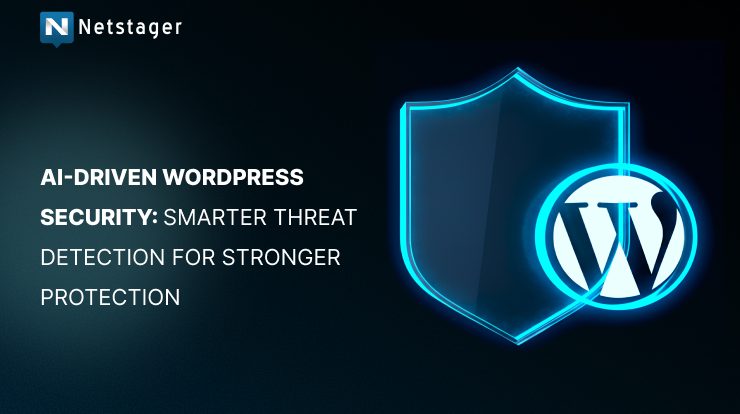
Contents
From Reactive to Proactive Security
For a long time, the security model for many WordPress site owners was essentially “fix it when it breaks.” You’d monitor for signs of a visible breach and then try to restore the site or patch the hole after the attack had already done its damage. The main drawback here is pretty clear: by the time you actually notice the problem, you’ve likely already suffered downtime, lost data, or had your reputation dinged. It’s too risky.
With the aid of AI, website security moves into a much more proactive stance. It means the system is continuously monitoring activity, spotting weird behaviour or anomalies in real-time, and responding automatically to anything suspicious. This shift is utterly necessary because, let’s be honest, attackers are using automation, too bots relentlessly scan for weak plugins, old themes, or people using “123456” as a password.
How AI Enhances WordPress Security
- Behavioral & Anomaly Detection: AI models first need to learn what your site’s normal looks like typical traffic levels, where users usually log in from, what files get changed and when. When something wildly deviates say, a login attempt suddenly pops up from a server in a country you’ve never had visitors from, or you see a massive spike in failed login attempts, or perhaps a core plugin file is modified unexpectedly the system immediately flags it.
- Machine Learning + Predictive Scans: Unlike older, static, rule-based systems that only know what they’ve already been told, AI can anticipate new or evolving threats, including notorious zero-day exploits. It does this by analyzing broader patterns and risk indicators before the vulnerability is publicly known. This may suggest a significant advantage over competitors.
- Automated Response: Once a threat is confidently detected AI powered tools can jump into action immediately. They can block a suspicious IP address, isolate a compromised file (like moving a maliciously injected PHP file into quarantine) or fire off an urgent alert to the administrators all without waiting for a human to wake up and grab their coffee.
- Continuous Adaptation: The best part? AI systems get better over time. As they gather more data from millions of login attempts, new malware signatures, and file-change events across a network of sites they continuously refine their definition of what’s “normal” versus what’s a clear “threat.” In simple terms, your protection only gets stronger the longer you run it.
Why WordPress Sites Are Particularly Vulnerable
- Out-of-date components: This is probably the biggest one. Attackers actively scan for known vulnerabilities in abandoned or old add-ons. If you’re running a four-year-old gallery plugin that hasn’t seen an update, you’ve left a door wide open.
- Weak Credentials: Reused passwords or, worse, not using multi-factor authentication (MFA) is asking for trouble.
- Bad Code: Themes or plugins built by unvetted third parties, or custom work that didn’t go through a security audit, often introduce easy security holes.
- Automated Attacks: We’re dealing with bots and automated scanning tools that seek out weak sites in bulk.
Because these threats are constantly shifting and improving, our defense systems simply need to get smarter we can’t just keep doing the same old thing.
Implementing AI-Driven Security for WordPress
If you manage a WordPress site be it a portfolio, a small e-commerce shop, or a big corporate landing page adopting AI-driven protection isn’t complicated.
A practical starting point is to choose a security plugin or tool that explicitly incorporates AI/ML features, like behavioral analytics. Once it’s installed, enable the baseline monitoring so the tool can spend a week or two “learning” your site’s standard login and traffic patterns. You should absolutely make sure your software is updated; AI helps detect threats, but keeping your core, plugins, and themes patched is still the non-negotiable foundation.
Also, don’t just rely on the AI alone. Layer your approach enable multi factor authentication (MFA) and limit who has admin privileges. Finally, take a moment every so often to review the alerts and check for “false positives.” The AI improves with data, but a human’s judgment is key to refining the model and making sure legitimate activity doesn’t get accidentally blocked.
The Future: Smarter, Self Healing WordPress Sites
- Self healing capabilities: Imagine a compromised file being automatically rolled back to a clean version from a secure backup, with the system simultaneously closing the exploited vulnerability without human intervention.
- Global threat sharing: AI systems across different sites learning from each other, instantaneously sharing knowledge of a brand-new attack pattern across the network.
- AI-assisted code reviews: For those who use custom themes or plugins, AI tools could scan the code for common vulnerabilities (SQL injection, XSS, etc.) before the code even goes live.
While AI isn’t a silver bullet no security system is perfect, after all when implemented correctly, it definitely tips the balance in favor of the site defenders. It gives WordPress owners a far stronger chance to spot threats early, respond rapidly and ultimately, keep their sites running safely.
As a leading WordPress Development Company in Calicut, Netstager Technologies helps businesses build secure, high-performance websites by integrating AI-driven security practices that strengthen protection and enhance long-term reliability.
Conclusion
If you run a WordPress website, the time to think about smarter security is now. AI driven tools transform passive defenses into active, tireless watchers constantly learning, detecting threats early, and responding quickly.
But remember the basics keep your software updated, use strong passwords and MFA, choose quality themes and plugins and stick with responsible hosting. AI doesn’t replace these foundations it complements them. Together, they create a truly resilient ecosystem.




